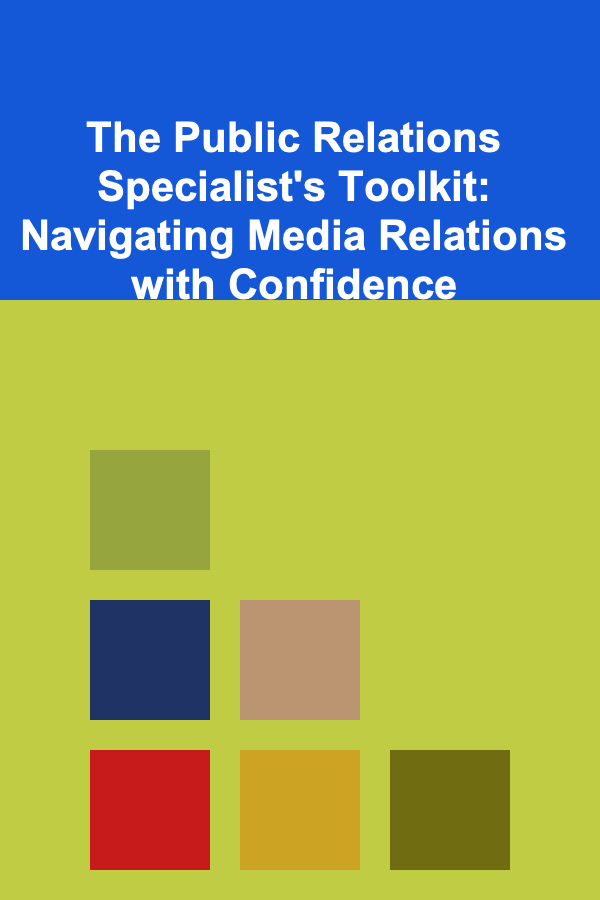
The Public Relations Specialist's Toolkit: Navigating Media Relations with Confidence
ebook include PDF & Audio bundle (Micro Guide)
$12.99$10.99
Limited Time Offer! Order within the next:

Public Relations (PR) specialists are the behind-the-scenes architects who build, shape, and maintain a brand's image. Media relations are at the heart of their work, ensuring that messages are communicated clearly and effectively to the right audience. Navigating media relations with confidence requires a strategic approach, understanding of media dynamics, and the right tools to ensure that the PR efforts achieve maximum impact. In this article, we will explore the essential components of a PR specialist's toolkit, the role of media relations, and actionable strategies to foster strong relationships with journalists and the media.
The Role of a Public Relations Specialist in Media Relations
Public Relations specialists serve as the bridge between an organization and the public, particularly the media. They are tasked with crafting stories, pitching them to journalists, and managing the flow of information to shape how a brand is perceived. Media relations, specifically, focuses on maintaining productive relationships with media outlets, journalists, bloggers, and influencers.
A successful PR campaign hinges on building these relationships to gain media coverage that not only informs the audience but also positively influences perceptions of the brand.
The goal of media relations is to:
- Increase brand visibility and awareness.
- Establish and maintain a positive reputation.
- Influence public opinion and behavior.
- Manage crisis communications, if necessary.
- Position key stakeholders as thought leaders in their industry.
For a PR specialist to navigate media relations confidently, they must be prepared to tackle both strategic and tactical aspects of media engagement, ensuring their outreach is relevant, timely, and newsworthy.
The Essential Toolkit for Media Relations
To effectively manage media relations, PR specialists rely on a combination of tools, strategies, and best practices. The following toolkit outlines the key components that every PR professional needs to succeed in the world of media relations.
1. Media List & Database
One of the foundational tools in any PR toolkit is the media list. This list contains the contact information for journalists, reporters, editors, bloggers, and influencers who cover topics relevant to your industry. A well-curated media list is essential for effective media outreach.
Building a Media List:
- Identify Relevant Media Outlets: Research and identify the most influential media outlets in your industry. These could be trade publications, national newspapers, local news stations, or niche blogs.
- Segment the List: Group journalists and outlets based on specific beats, such as technology, lifestyle, or business. This ensures that you're sending the right message to the right person.
- Include Detailed Contact Information: For each journalist or outlet, include their preferred method of contact, the best time to reach them, and any specific interests or editorial focuses.
A well-maintained media list ensures that your pitch is delivered to the right journalist who is most likely to cover your story.
2. Press Release
A press release is one of the most commonly used tools in PR. It's an official statement issued to the media to provide information about a newsworthy event, product launch, partnership, or any significant development within the company.
Best Practices for Crafting a Press Release:
- Start with a Compelling Headline: The headline should grab attention while succinctly summarizing the news. A strong headline increases the likelihood of your press release being read.
- Craft the Lead: The first paragraph should answer the 5 W's---Who, What, When, Where, and Why. It should be clear, concise, and informative.
- Provide Quotes: Including quotes from key stakeholders, such as executives, adds credibility and a human touch to the release.
- Include Relevant Details: Ensure that all pertinent details are included in the body of the press release. Keep it informative, but avoid overloading the reader with unnecessary jargon.
- End with a Boilerplate: This is a standardized paragraph that provides a brief description of your company or organization, helping journalists understand your background.
Tip: Always include media contact details at the bottom of the press release so journalists know how to reach out for follow-up inquiries.
3. Media Pitch
A media pitch is a personalized communication sent to a journalist, editor, or media outlet to propose a story idea. Unlike a press release, which is a formal announcement, a pitch is a more informal and conversational invitation for the journalist to cover your story.
Tips for Writing an Effective Media Pitch:
- Personalization: Always tailor your pitch to the specific journalist you're reaching out to. Show that you've done your homework and understand the type of stories they cover.
- Clear and Concise: Journalists receive hundreds of pitches, so keep yours short and to the point. Focus on why your story is relevant to their readers and how it ties into current trends or issues.
- Hook: Start with a compelling hook---something that grabs the journalist's attention and entices them to read more.
- Call to Action: Always include a clear next step in your pitch. Whether it's scheduling an interview or providing additional information, make it easy for the journalist to take action.
4. Media Kit
A media kit is a comprehensive package that provides journalists with all the information they need about your brand, product, or service. It's essentially a one-stop resource that can be used to support stories or articles.
Components of a Media Kit:
- Company Background: An overview of your company's history, mission, and values.
- Product or Service Information: Key details about what you offer, including benefits and differentiators.
- Bios of Key Personnel: Short biographies of the company's key leaders, including photos.
- Recent Press Coverage: Highlight articles or stories that have been covered in the media to build credibility.
- Multimedia Assets: High-quality images, logos, videos, and other visuals that can be used by journalists in their coverage.
A media kit should be easily accessible and kept up-to-date, so journalists can find everything they need to cover your brand in one place.
5. Press Briefing & Media Interviews
When a journalist expresses interest in your story, offering a press briefing or interview with key stakeholders can be a powerful way to communicate your message in greater detail.
How to Handle Media Interviews:
- Prepare Thoroughly: Know the key messages you want to communicate, anticipate questions, and prepare answers for both easy and tough inquiries.
- Stay on Message: Ensure that you're communicating your key messages throughout the interview. Be concise and avoid tangential discussions.
- Be Transparent: Journalists appreciate honesty, even if it's about difficult topics. Be upfront and provide clear, factual information.
- Follow Up: After the interview, send a thank-you note and offer any additional resources or clarification they may need for their story.
6. Monitoring & Analytics Tools
Once your PR efforts are underway, it's crucial to measure their effectiveness. Monitoring tools help track media coverage, sentiment, and audience reach, while analytics tools allow you to assess how your press releases and media outreach are performing.
Key Metrics to Track:
- Media Mentions: How often and where your brand is mentioned in the media.
- Reach and Impressions: How many people have been exposed to your story or coverage.
- Audience Sentiment: Whether the media coverage is positive, negative, or neutral.
- Website Traffic: Whether media coverage leads to increased visits to your website or landing pages.
By utilizing media monitoring and analytics tools, PR specialists can adjust their strategies in real time and ensure they're effectively measuring the impact of their media outreach.
Navigating Media Relations with Confidence
Navigating media relations is an ongoing process that requires continuous learning, adaptation, and relationship-building. Confidence in media relations comes from understanding the needs and motivations of journalists, mastering the art of storytelling, and having the tools necessary to support your efforts.
To navigate media relations confidently, keep these tips in mind:
- Always Be Proactive: Don't wait for the media to come to you. Seek out opportunities to pitch your stories and build relationships with journalists.
- Be Respectful of Journalists' Time: Journalists work on tight deadlines. Always be respectful, responsive, and accommodating when they reach out for information.
- Stay Authentic and Transparent: Authenticity is key in building trust. Be truthful, and always act in the best interest of your audience.
- Adapt to Media Trends: The media landscape is constantly evolving. Stay on top of trends and adjust your strategies accordingly. Whether it's the rise of podcasts, video content, or social media influencers, always be ready to embrace new forms of media.
Final Thoughts
In the ever-evolving world of PR, the media relations toolkit is a dynamic and essential resource for building visibility and trust. With the right strategies, tools, and mindset, PR specialists can confidently navigate media relations and drive their brands toward success. The key is to remain agile, maintain strong relationships with media professionals, and deliver compelling stories that resonate with both journalists and the public.
Reading More From Our Other Websites
- [Personal Care Tips 101] How to Use Herbal Remedies for Menopausal Hot Flashes
- [Home Family Activity 101] How to Create a Family Yoga Routine for Relaxation
- [Personal Care Tips 101] How to Choose the Right Exfoliating Scrub for Your Budget
- [Organization Tip 101] How to Create a To-Do List That Actually Works
- [Personal Care Tips 101] How to Use Shaving Cream to Create the Perfect Shave for Sensitive Skin
- [Home Rental Property 101] How to Set Up a Profitable Home Rental Business
- [Organization Tip 101] How to Store Your Time Capsule for Longevity
- [Soap Making Tip 101] Handling Lye Safely: Step-by-Step Precautions for Soap Creators
- [Home Budget Decorating 101] How to Design a Functional Yet Stylish Home on a Budget
- [Digital Decluttering Tip 101] Digital Detox: Streamlining Your Devices for Better Focus and Productivity

How to Build a Solid Credit History Without Getting Into Debt
Read More
How to Create a Cozy and Organized Guest Room
Read More
How to Maximize Closet Storage Without Overcrowding
Read More
How to Organize and Decorate Your Small Apartment on a Budget
Read More
How To Understand the Future of Wireless EV Charging
Read More
How to Knit Socks: A Beginner's Checklist
Read MoreOther Products

How to Build a Solid Credit History Without Getting Into Debt
Read More
How to Create a Cozy and Organized Guest Room
Read More
How to Maximize Closet Storage Without Overcrowding
Read More
How to Organize and Decorate Your Small Apartment on a Budget
Read More
How To Understand the Future of Wireless EV Charging
Read More